Par Fanny Burger, Clémence Sutter, Yasmine El Ansari, Alessio Vitale, Baptiste Joie, Alexis Furstenberger, William Schmitt, Yann Keshvary-Rad, étudiants ESTA Belfort
Mots clés : #Greenhouse gas #Net Zero #carbon capture #storage #CO2 emissions
“The world has a huge challenge ahead of it to move net zero by 2050 from a narrow possibility to a practical reality!”
July 29th 2021 = «Overshoot Day»
It means that humanity has spent all the resources that the Earth can regenerate in one year.
Calculated by ONG Global Footprint Network, this date is based on three million statistical data from 200 countries.
This is the date from which the ecological footprint exceeds the planet’s biocapacity. It also marks the moment when our greenhouse gas emissions from burning fossil fuels will be more important/ significant than our oceans and forests can absorb.
Currently, we use 74% more than the planet’s ecosystems can regenerate which is equivalent to the resources that 1,7 Earths would produce!
How to postpone this date? By using the exact amount of energy, the earth can produce and by limiting CO2 emissions with the aim of carbon neutrality. Net Zero is our chance for a sustainable future.
What is Net Zero?
Net zero refers to a state in which the greenhouse gases going into the atmosphere are balanced by removal out of the atmosphere. Net Zero means that for every molecule of Greenhouse gas we put into the air we also take one out making our net emissions zero.
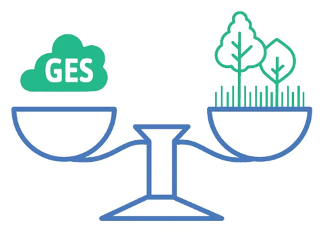
We reach net zero when the amount we add is no more than the amount taken away.
Net ZERO as the goal
Net zero is important as it’s the best way we can tackle climate change by reducing global warming. With action on reducing all other sources of GHG (greenhouse gas) emissions, achieving net‐zero CO2 emissions from the energy sector by 2050 is consistent with around a 50% chance of limiting the long‐ term average global temperature rises to 1.5°C without a temperature overshoot!
Net Zero requires making big changes today, use less or more efficiently. Even bigger technological changes like replacing all greenhouse gas emitting activities with clean ones.
Moreover, the number of countries that have pledged to reach net-zero emissions by mid-century (or soon) continues to grow. By the end of 2021, over 80 countries, representing almost 75% of global emissions, announced commitments to achieve net-zero emissions. That’s motivating and it helps people, industries and government to keep continuing in that way.
To reach Net Zero we have to do a total transformation of the energy system, COP26 focused the fact that we need to strengthen global ambitions and actions on climate by building on the foundations of the 2015 Paris Agreement.
How can we reach it?
IEA made a Roadmap focusing on a pathway the most feasible, cost-effective and socially acceptable. Their Roadmap is global in scope, but each country will need to design its own strategy.
Technology deployment, the need of innovation
Between 2030 and 2050 there is also a question of the rapid deployment of existing technologies but also of solutions that are not yet operational. We need to use the actual technologies and in parallel develop new solutions. Indeed, in the IEA’s projections for achieving neutrality, nearly half of the expected emissions reductions in 2050 are enabled by technologies at the prototype stage. This is particularly the case for heavy industry and long-distance transport. The biggest opportunities for innovation highlighted by the IEA are next-generation batteries, electrolytic hydrogen, and direct air capture and storage.
Increasing of renewable energy
Regarding the increase in the use of renewable energies, the 2020-2030 decade is marked by an expansion of renewable energies with some striking figures: +630 GW of additional solar photovoltaic in 2030 and +960 GW for wind power (four times more than the level of 2020, which is already a record), still relying on hydroelectric and nuclear power plants, which for the IEA are an essential foundation for this transition.
The IEA projects that by 2050, two-thirds of the world’s energy supply will come from renewables (solar, wind, hydro, bioenergy, geothermal). Solar energy would be the dominant source, with a capacity that would be multiplied by 20 compared to the current level. Fossil sources would be restricted to a few uses (carbon capture facilities, plastics, sectors with limited low-carbon technologies).
The absolute priority is to generate decarbonized electricity as soon as possible to electrify entire sectors of the economy, such as transportation. Indeed, this scenario sees the share of electric vehicles in global sales increase from the current 5% to over 60% in 2030.
Vast amount of investment & international co-operation
In order to respect a trajectory compatible with the 2050 neutrality objective, the IEA recommends a sevenfold increase in annual investments in clean energy in emerging and developing countries.
These are standards that must be put in place, otherwise CO2 emissions from energy-related economies will increase by nearly 5 Mds t CO2 in Asia, Africa and South America over the next two decades.
Financing the investment
Financing the investments needed to achieve Net Zero Emissions by 2050 would involve redirecting existing capital to clean energy technologies and also increasing the overall level of investment in energy.
It costs twice as much to avoid one ton of CO2 emissions in developing countries as in advanced economies because there is much less to dispose of. This explains the fact that it is possible to switch to more efficient technologies in these countries as there will not necessarily be emitting facilities already in place.
How is it financed?
Most of this increased investment is coming from private sources.
These are mobilized by public policies that reform energy taxes.
However, direct public funding is necessary to stimulate the development of new infrastructure projects and accelerate innovation in technologies (currently in the demonstration or prototype phase).
For the developing economies and emerging markets, projects are often relatively reliant on public financing.
International co-operation
In order to facilitate international capital flows, many countries have made efforts to cooperate with each other and are committed to the goal of net zero by 2050.
People behavior
The transition to net zero is for and about people. 5% of the emissions reduction will be due to behavior change. Citizens must be active participants in the entire process, they need to be part of the transition. It’s not that easy to do that big change so governments need to promote training and devote resources to facilitating new opportunities.
Decarbonization’s milestones
Here are some clear milestones for what needs to happen and when, to transform the global economy from one dominated by fossil fuels into one powered predominantly by renewable energy.
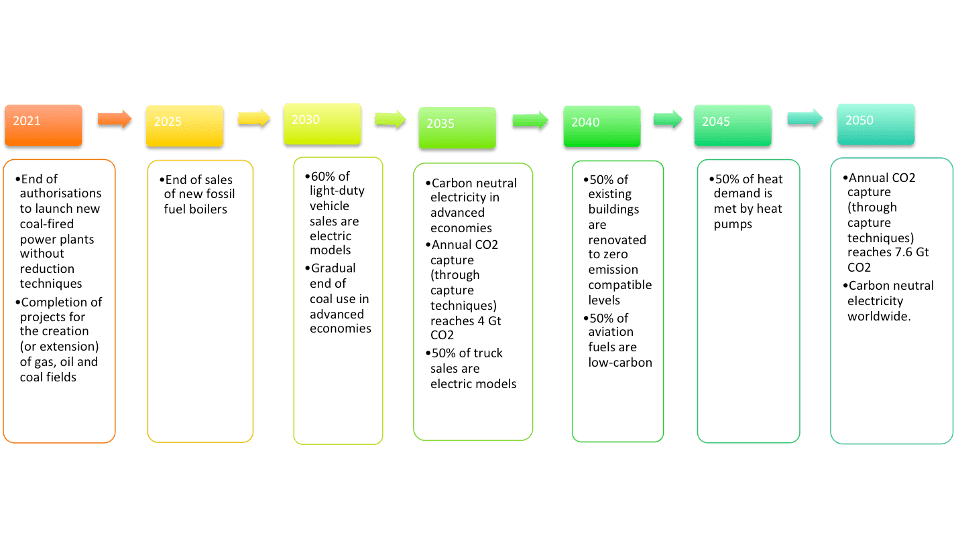
Every country, sector, industry and each one of us must work together to find ways to cut the carbon we produce.
Capture Carbon
Growing interest in Direct Air Capture for Net Zero
Direct Air Capture (DAC) is a technology for capturing CO2 from the air and from the atmosphere. This technology could be very useful to contribute to climate change and some countries, companies and investors have decided to support Direct Air Capture. The goal with the Net Zero Scenario is to reach around 980 MtCO2 (million Tonnes of carbon dioxide) in 2050. The term “net” refers to balancing any CO2 that is released into the atmosphere from human activity with an equivalent amount being removed.
To capture the CO2, we need to have facilities and across the world there are 18 plants operating especially for DAC. These plants are mainly based in the USA, Canada and Europe.
There are some companies which are supporting and leading the development of the DAC technologies, in particular the Swiss company called Climeworks AG. In fact, this company has commissioned 15 of the 18 plants.
It’s not alone as other smaller companies are also involved in the commercialization of DAC technologies such as Carbon Engineering Ltd and Global Thermostat.

After capturing the CO2 from the air, we have 2 possibilities: we can store it and we can use it to produce different types of products such as for the synthetic aviation fuels, food and beverages. Most of these 18 plants are very small and are specializing in DAC for use. There are only two plants in Iceland which are capturing CO2 from atmosphere and to blend it with CO2 from geothermal fluids to store it underground and to form rocks. So, they are turning CO2 into rocks through mineralization. Currently, one of this plant is the biggest for DAC thanks to its expansion in 2021. They can capture approximately 4000 tCO2 per year.
As we can see on the graphic just below, in the Net Zero Scenario in 2050, we essentially want to store the CO2 rather than for using. To remind, the goal is to capture almost 1000 MtCO2 so the storage will represent approximately the 2/3 of the DAC. We need to build new plants like in Iceland which are specializing in the underground storage of CO2.

Direct Air Capture is part of the Net Zero Scenario but there is another solution to capture the CO2 which is the Biomass also called BECCS.
As we can see on the graphic below, in 2050 in the Net Zero Scenario, we want to improve and equilibrate the capture of CO2 from DAC and Biomass.
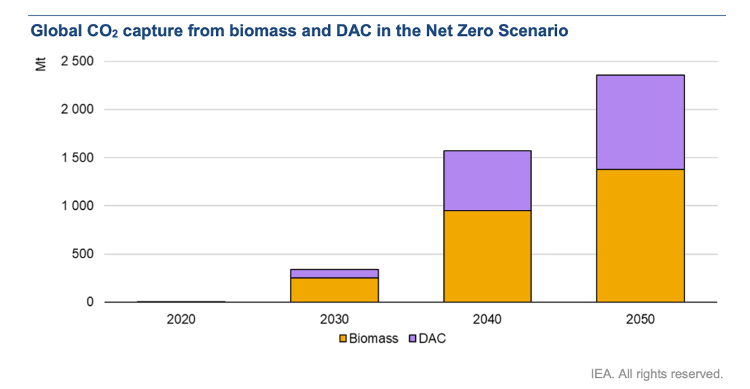
Technologies to capture CO2 from the air
Solid and liquid direct air capture:
Two technology approaches are presently being used to capture CO2 from the air solid and liquid DAC.
Solid DAC uses a solid filter that reacts chemically with CO2. When the filter is heated, it releases the CO2 which can be stored or used.
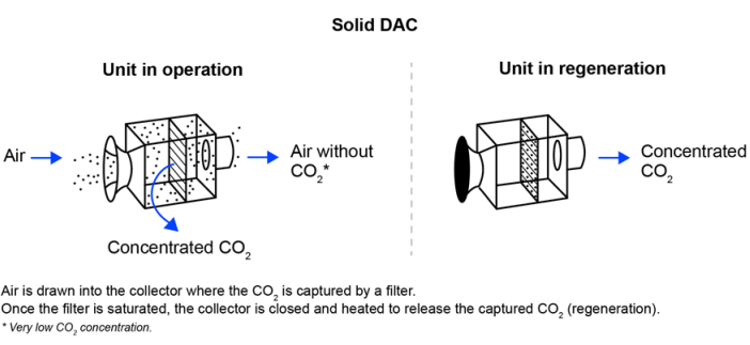
Liquid DAC first passes the air through a chemical solution removing the CO2 and returns the air to the outside and then the CO2 is extracted from the solution by heating.
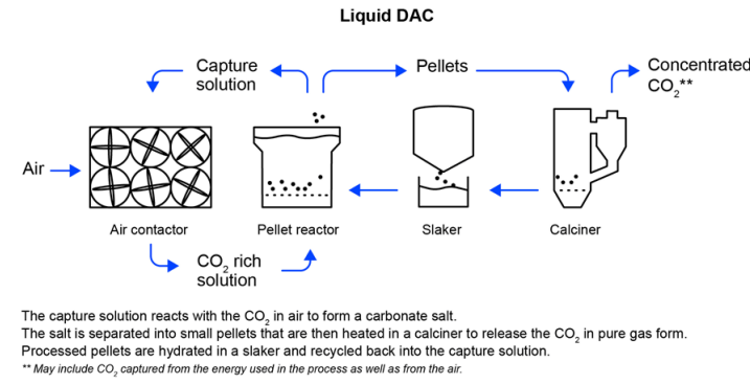

Emerging direct air capture technologies:
Emerging DAC technologies include electro-swing adsorption (ESA) and membrane-based DAC (m-DAC).
ESA is based on an electrode that absorbs CO2 when the charge is negative and releases it when it is positive. This method allows CO2 to be separated from both air and more concentrated sources. The technology has been tested with an efficiency of 90% but further work is required to commercialize it.
m-DAC requires a high pressure for the membrane to separate CO2 from the ambient air due to its low concentration.
Current capture costs via DAC are high and uncertain:
Capturing CO2 from the air is more expensive than capturing it directly at the source because of the concentration. The more diluted the CO2, the higher the energy cost.

Costs also vary according to the type of liquid or solid technology. Once captured, the CO2 must be either geologically stored or used immediately at low pressure. For storage, the CO2 must be compressed and injected into geological formations.
According to IEA estimates, the cost of large-scale capture (1MtCO2/year) would be USD 125-335/tCO2 depending on the technology, energy price, configuration etc. If the price reaches USD 160/tCO2, carbon capture could become profitable.
The potential for reductions in the cost of direct air capture is considerable:
DAC technology has considerable potential for performance and cost reduction. The goal is to bring the cost per tonne captured down to around USD 100 over the next decade.
Key considerations for direct air capture deployment
To reach the Net Zero Scenario goals which are significant but not impossible for the DAC development, we need to build each year a lot of new DAC plants.
Here, is the plant construction program we need to meet to reach the final goal in 2050:
From now to 2030: construction of 8 large-scale DAC plants each year
From 2030 to 2040: construction of 50 plants each year
From 2040 to 2050: construction of 40 plants each year
All these constructions are necessary to obtain the 980 MtCO2 of CO2 capture. Obviously, with these constructions, we need to expand the global supply chains for different products.
These plants will also need a lot of energy per year to capture almost 1 GtCO2. For comparison, the energy needs will be equivalent to all the energy the Netherlands has exported in 2019, that’s huge.
Here are all the energy needs for the different capture of CO2. For example, we can see that Liquid Direct Air Capture, whether for storage or for use, need less energy than Solid Direct Air Capture.
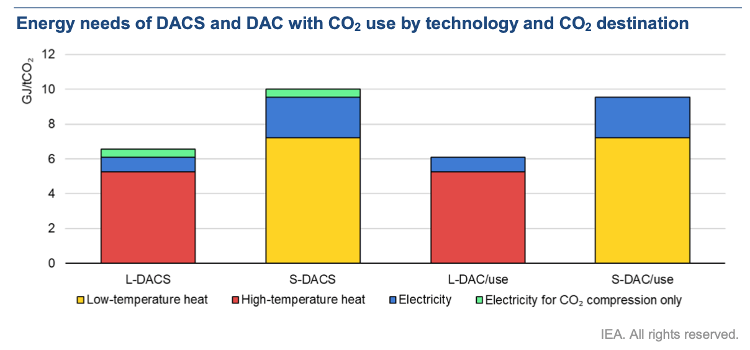
However, S-DAC plants can use some renewable energy sources for example heat pumps, solar thermal and geothermal to work.
Currently L-DAC can’t work with renewable energy because plants need high temperatures and renewable energy is not enough to have high temperatures.
In addition to energy, Direct Air Capture plants need a lot of water to capture CO2. Especially Liquid DAC requires a lot of water for its operation. Solid DAC doesn’t need water because depending on conditions it can extract water from the air.
Optimal locations for direct air capture
One of the main advantages of the direct air capture is that a factory can be located almost anywhere, for instance near a suitable storehouse point for carbon junking, or a manufactured complex seeking a force of atmospheric (rather than reactionary) CO2 feedstock, lowering the need for long- distance CO2 transport.
However, despite these sitting facilities this technology still has some limitations. Indeed, for now DAC plants have been tested in Europe and North America but it still needs further testing for climate that are either extremely dry or humid and even high polluted climate.
Moreover, the choice of location needs to take in account the energy source available there, indeed this will greatly affect the efficiency of the capture.
Capture cost by location :
As said before the DAC has been tested mainly in Europe and North America because these regions have the potential for co-siting with existing industrial hubs as well as existing and planned CO2 transport and storage infrastructure.
To be cost-competitive a region needs to have either a very high renewable energy potential, low natural gas prices, or a strong interest in CO2 use and the carbon circular economy.
Different countries have some of these characteristics (North Africa, the Middle East, Russia Federation, Japan).

Energy sources :
When a region is characterized by high renewable eventuality, the assessment of its suitability for substantial DAC deployment should take into regard several additional factors related to land use and land use change (the degree of urbanization, the presence of natural Territories and ecosystems, and marine defended areas).
Other sources of energy that could be used to power DAC include nuclear,geothermal and hydropower factories. Utmost, numerous hydropower factories are located across South America, Eastern Europe and southern China, while geothermal plants are located along the west seacoast of the United States and Mexico, and in Japan and the Philippines. Meanwhile, nuclear plants are substantially located in the eastern United States, Europe (especially in France), along the east seacoast of China and in Japan for the moment but several reactors are being decommissioned.

Use and storage of air-captured CO2 :
Once CO2 has been captured from the atmosphere it can either be stored underground or be used directly or indirectly. For now, out of the 18 DAC only 2 of them are storing CO2.
However, in the IEA Net Zero Emissions Scenario, 95% of the total CO2 captured should be stored rather than used. Of the 980 MtCO2 captured via DAC in 2050, 630 MtCO2 is permanently stored while 350 MtCO2 is for CO2 use (mainly for aviation fuels).
There are different ways to stock the CO2 captured through DAC, it can be stored geologically in deep saline aquifers (having the largest storage capacity), in depleted oil and gas fields, and in other rock formations such as basalt.
Direct air capture as part of a carbon dioxide removal portfolio
What is carbon dioxide removal?
CDR (carbon dioxide removal) is a term that refers to approaches that draw CO2 from the atmosphere, directly or indirectly, and permanently store it. Removing carbon from the atmosphere will play an important role in meeting climate goals especially as it can help reduce or balance CO2 emissions in sectors hard to reduce (because they are either too costly or because it is technically too difficult).
It can also help reaching enable “net negative” emissions at a global scale. Thus, it can remove historical emissions that have accumulated in the atmosphere.
To limit the future temperature increases to 1.5°C all existing IPCC models includes CDR deployment and most of them includes net negative emissions in the second half of the century.
What are the main carbon dioxide removal options?
The range of carbon removal approaches includes nature-based and technology-based options, and options that enhance a naturally occurring process. They remove CO2 either directly from the air (DAC) or indirectly (biomass growing) and store the CO2 either geologically, within the terrestrial biosphere (within soils, minerals or biomass), or in the ocean.

Scaling up the deployment of direct air capture
Support for direct air capture
Growing recognition of DAC technologies’ important role in meeting net zero goals is translating into increased policy support and investment. Since the start of 2020, almost USD 4 billion in funding has been announced specifically for DAC research, development and deployment (RD&D), while leading DAC companies have raised around USD 125 million in capital.
Plans for nine DAC facilities are now in development. If all of these planned projects were to go ahead, DAC deployment would reach around 3 MtCO2 by 2030; this is more than 380 times today’s capture rate, but a mere 3.4% of the level of deployment needed in the Net Zero Scenario.
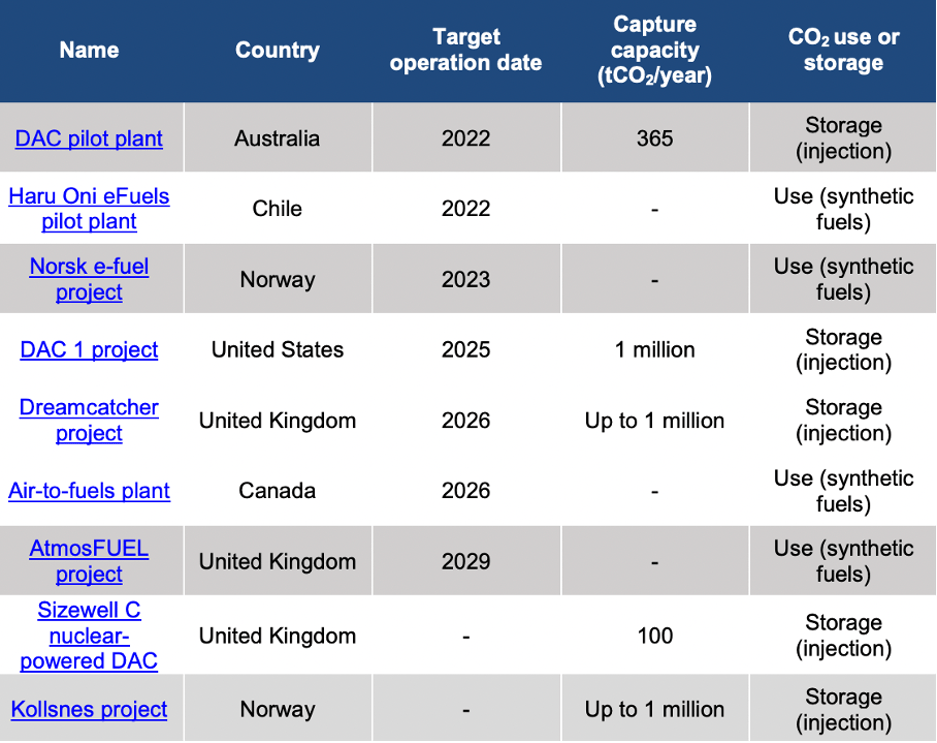
Business models for direct air capture :
There are two primary commercial drivers for investing in DAC technologies:
1) selling high-quality carbon removal services when DAC is combined with CO2 storage
2) selling climate-neutral CO2 as a feedstock for a range of products, including aviation fuels and beverage carbonation.
DAC companies are offering commercial removal services to individuals as well as companies willing to pay a recurring subscription to have CO2 removed from the atmosphere and stored underground on their behalf. The price of the subscription varies (depending on the amount of removal purchased) from USD 600/tCO2 to USD 1 000/tCO2, although price details for the larger commercial deals are not available.
Selling the CO2 for use in industrial applications:
Most DAC facilities currently in operation generate revenue from selling the captured CO2. While the largest industrial uses of CO2 today are in fertilizer production and enhanced oil recovery, future large-scale opportunities to use CO2 include the production of chemicals, fuels and building materials.
Six priorities for direct air capture deployment :

Références
Data and statistics. (2020). Iea. Https://www.iea.org/data-and-statistics
Iea publications. (2021, octobre). Net zero by 2050 a roadmap for the global energy sector. International energy agency. Https://iea.li/nzeroadmap
Iea publications. (2022, avril). Direct air capture a key technology for net zero. International energy agency. Https://www.iea.org
Net zéro : l’aie propose une feuille de route mondiale pour la décarbonisation du secteur de l’énergie. (2021). Https://www.citepa.org/fr/2021_06_a07/.
What is net zero and what does it mean? (2020). https://www.twi-global.com/technical-knowledge/faqs/what-is-net-zero

I watch the video and I’ve never heard about Direct Air Capture (DAC), I think that people should talk more about that. We are talking too much about the fact that we have to decrease our consumption and I find this article very enriching. Thanks a lot for your article!
J’aimeAimé par 1 personne
I have often heard about the « overshoot day » and you wrote that it took place on July 29 for the year 2021.
But do you know what the situation is for the other years?
Since how long have we been passing this date ?
And has there been an unexpected change in the evolution of this date due to the impact of the health crisis ? (I’m thinking of the knock-down, industry downturn, etc…)
Thank you very much for this article and the video !
J’aimeJ’aime
First of all, I wanted to thank you for your question. The calculation of the « overshoot day » varies every year depending on the ecological footprint of the human being. As man consumes more and more resources, the date is getting earlier and earlier. In 1983, the first date was December 31 and until today the date has only moved backwards with the exception of 2020 with 3 weeks later. In 2019, the date was already July 29 and considering the current trends, the next one will be even earlier.
J’aimeJ’aime
Thank you for this clarification about my previous questions!
J’aimeJ’aime
Thank you for your explanations concerning the date at which humanity has consumed all the resources that the planet can generate in one year. I find it alarming that this date is set 4 months before the end of the year…
Do you think that investing massively in renewable energies and technology is the best solution to reach net 0 emissions?
Your technology presentations are very detailed and allow us to see how the technologies available to us work.
But doesn’t the capture technologies you present consume more energy and therefore more emissions than what they capture?
Personally, I think that in the future the companies in charge of carbon capture will be profitable by selling a « right to pollute » for the industries that emit above the thresholds. This will require an increase in the carbon tax at the international level.
J’aimeJ’aime
Thanks a lot for this article that brought me a lot of hope regarding the future of our GG emissions ! As a future actor of the fashion industry, i would be delighted to hear about your personal advices to reduce a lot the GG emissions in this industry, as it is said to be the fifth largest emitter of greenhouse gases. How to raise awareness among the youngest ones, that are the most influenced by the fast and ultra-fast fashion brands ? Thanks for your answer and again, great job on the article !
J’aimeJ’aime
Hello and thank you for your interesting article !
Over the past months, I have been looking a little more at climate drift.
It is after reading a lot of articles like yours that I came to the tragic conclusion that the ONLY condition for the success of this scenario and the rescue of our planet, lies in the changes in the individual behaviour of the population.
Indeed, many short-term solutions are proposed each year to try to reduce overall consumption. Inefficient solutions with too low impact… just to allow us keeping our current comfort of life. This is no longer possible today ! To achieve such an objective, there is a radical change in the way of life of the population to establish. The problem is that radically changing your way of life is complicated because it requires sacrifices, just like top athletes who make sacrifices to become the best. These athletes have made the choice to change, the choice to fight and get out of their comfort zone. In my opinion, it is necessary to do the same if we want to achieve this objective one day.
J’aimeJ’aime
wow!! 33Capture Carbon: a way to reach Net Zero by 2050 ?
J’aimeJ’aime
What data is used to determine the date when ecological footprints exceed the planet’s biocapacity? regard <a href= »https://jakarta.telkomuniversity.ac.id/menyelami-dunia-botnet-ancaman-tersembunyi-di-era-digital/ »> Tel U</a>
J’aimeJ’aime